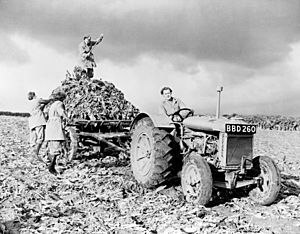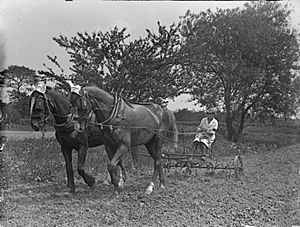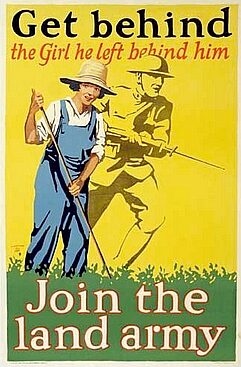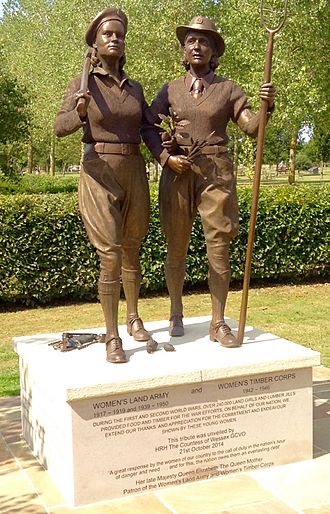Women's Land Army facts for kids
The Women's Land Army (WLA) was a special group of British women. They helped their country during both the First World War and the Second World War. Their main job was to work on farms. This was important because many men had gone to fight in the military.
Women in the WLA were often called Land Girls. They did all kinds of farm work, like planting and picking crops. They also looked after animals. They helped make sure Britain had enough food during wartime.
Contents
History of the Land Girls
First World War Efforts
Before the WLA, a group called the Women's Farm and Garden Union was already helping. In 1916, they suggested creating a special group for women to help with farming during the war. This led to the start of the Women's Land Army in 1917.
The WLA helped find women to work on farms. They also spread the word that women from all backgrounds could do this important work. At first, they needed many more volunteers than they had.
The Land Army eventually had about 23,000 women working on farms. These women took the place of men who had joined the army. They were paid a small wage for their hard work. Many more women also helped on farms without being part of the official WLA.
If a Land Girl did a really good job, she could earn a special "Good Service Ribbon." The WLA even had its own magazine called The Landswoman. The first Land Army ended in November 1919, after the war finished.
Second World War Revival
As another war seemed likely, the British government wanted to grow more food at home. In 1939, men were again called up for military service. This meant farms needed workers. So, the government brought back the Women's Land Army in July 1939.
The new WLA was led by Lady Denman. At first, women volunteered to join. Later, some women were asked to join as part of a national effort. By 1944, over 80,000 women were members of the WLA.
Most Land Girls already lived in the countryside. But many also came from big cities like London. In 1942, a separate group was formed for women who worked in forests. They were called the Women's Timber Corps, but people often called them "Lumber Jills." They helped cut down trees for wood.
During the Second World War, a woman named Amelia King was unfairly told she could not work because she was black. Her local Member of Parliament, Walter Edwards, spoke up for her. Because of this, the decision was changed, and she was allowed to join. The WLA officially ended on November 30, 1950.
Remembering the Land Girls
For a long time, the Land Girls did not get much official thanks for their work. But in 2007, after a former Land Girl named Hilda Gibson campaigned, the government decided to give them special recognition.
In 2008, over 45,000 former Land Girls received a specially designed badge of honor. This badge showed how much their country appreciated their efforts.
There are also memorials to remember the Land Girls. In 2012, Prince Charles unveiled the first memorial in Scotland. In 2014, another statue was unveiled at the National Memorial Arboretum in England. These memorials help everyone remember the important work of the Women's Land Army and the Women's Timber Corps during both World Wars.
See also
- Australian Women's Land Army
- Air Transport Auxiliary, civilian female pilots who flew newly built planes from the factories to airfields
- Mechanised Transport Corps, British women's organisation that provided drivers for government departments and other agencies during WWII
- Women's Auxiliary Air Force
- Boatwomen's training scheme, a replacement for men conscripted from the inland waterways
- Home front during World War II
- Rosie the Riveter
- Victory garden





